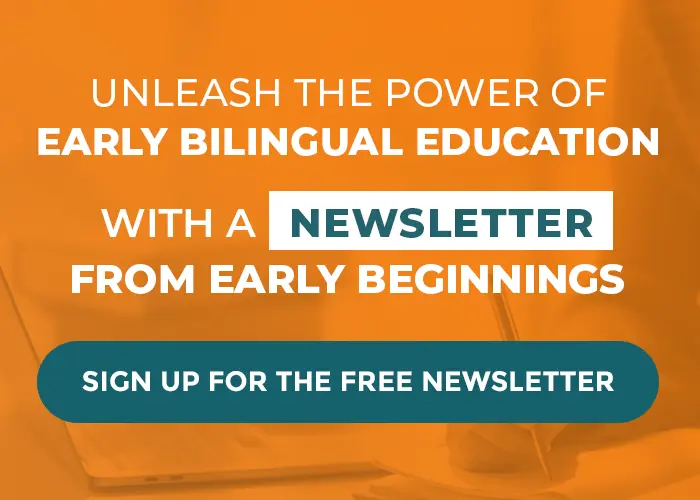“The SKILLS AND ABILITIES SET OUT in [name of any national curriculum] should form the basis for creating various possibilities of education programs in the country.”
(National curriculum guidelines from a non-English speaking country.)

That’s easier said than done, right?
It gets difficult for us, bilingual teachers, right? We are often teaching in English and have to follow a document that was not created with second language acquisition in mind.
So, what should we follow in terms of language objectives for a bilingual child? For example, in one national curriculum for 3-year-old children, we have the learning objective “Dialogs with children and adults, expressing their desires, needs, feelings, and opinions.”
How am I supposed to assess this in English?
This blog post WILL HELP YOU assess second language acquisition using your country’s national objectives. And to do this, we need to understand the concept that will save us: learning outcomes.
To understand the difference between a learning objective and a learning outcome, I’ll take you outside the world of education, into the “normal” world of relationships.
“What???”
“Yes, bear with me a bit…”
First, a make-believe journey…
Let’s imagine you have a couple of friends who need your help to resolve a conflict. And, of course, as a good friend, you agree to help. So you ask the couple what the conflict is so you can think about how to help them solve the problem.
The meeting is set, your goal is clear – to help your friends leave the conversation with their problem solved and live happily ever after – and you spend a few days coming up with good questions and thinking about the best situation and solution to resolve their problem.
The day comes when you do what you planned – put your plans into action – expecting the results of your efforts. You shared your ideas, had a nice discussion, and they both cried… But, after the conversation and while you were driving home, you realized you thought of everything except one thing: what results were you expecting? What came out of it? And how to know if your initial goal was achieved?
Is just feeling happy that you were helpful in your friends’ lives enough? Did they apologize? Did they set goals together at the end? Did they reflect and understand where the issue was? Were they able to listen to each other during the process? Did they see their mistakes and achievements? Did they recognize each other’s feelings? HOW DID THEY LEAVE THE MEETING?
This last question, “How did they leave the meeting,” can be put in other words in English: “What came out of it?” or “What was the outcome?”
If the point isn’t clear yet, let’s go a bit deeper into the concept.
The question is what would need to happen, what would need to come out of the conversation, for you to say that your initial goal – helping to solve your friends’ problem – was achieved?
Back to the world of education…
Now, bringing this idea to our world of bilingual education, what could the children do that would provide evidence that the general objective was achieved? It’s an extra step that, if you take it, will help you throughout the year in your assessments and bring more objectivity to the subjectivity of most learning objectives found throughout national curriculums globally.
The exercise, and yes, it’s an exercise, becomes easier the more you do it, just like any skill. The idea is to do what we did in the example above with the couple: take an objective and figure out how we will see that this objective was achieved. Understand what the child can do, through their behaviors (any action – evidence), that will show you they understood a concept or managed to perform a skill. But wait, we will help you even more.
Using some strategies…
Here’s a helpful strategy to answer the question: “I will know the child has achieved this objective if they can…” or “If the child does (this action), I will know they understood (this concept).” This way, you will have good ideas to guide you in your planning and assessment process.
As you can see, it will be necessary to do the same exercise with the same objective a few times, as, at least with the objective mentioned above, there are many aspects within a single objective. For example, “dialog with children and adults,” I can ask “Which children? All of them? Known ones? New ones?” And also “express desires, needs, feelings, and opinions.” Which ones? In which contexts? To whom?
Of course, I wouldn’t expect the child to say they need to go to the bathroom to the people at the front desk at school!
But creating learning outcomes will help you break down very broad objectives into the most important elements, considering your specific context so you can plan and assess. Let’s get practical now!
Putting it into practice…
So, let’s take the same objective we are using and create good learning outcomes that you can use in your classroom.
“Dialog with children and adults, expressing their desires, needs, feelings, and opinions.”
To show how it works, we need to create a common classroom context for 3-year-old children:
How about imagining that some of the children in our fictional class attended school last year and have already been exposed to the language for a year, and along with them, we have some new children to the school and the English language.
Sound familiar?
And let’s create a group context where the teacher is working on the children’s perception of their biological needs – after all, it’s potty training time! And while we are at it, let’s imagine it’s also a cold season – it’s just another perception to work on in our fictional classroom.
Now that we have created the general context, let’s move to the next step in creating a learning outcome: the use of specific verbs. It’s necessary to use words that show actions observable by the teacher. For example, using verbs like identify, pick up, speak, choose, gather, name, arrange, show, and others, leads the teacher to a more realistic assessment.
The less we think “is (this child) doing what I think they are doing,” the closer we get to an objective assessment.
You can do it just once, right? NO WAY!
What about frequency? Will it be valid to write down that the child achieved the learning objective if they performed that action only once or only in a specific place? Therefore, it is also interesting to include the frequency or some indicator of space and time in the learning outcome.
Considering these points, we can summarize the two issues I just mentioned by completing the following phrases:
“I will know the child has achieved this objective if they can…”
“If the child does …, I will know they understood ….”
Since we chose a linguistic objective – a skill – let’s try to complete the first phrase using our knowledge of the fictional context.
In fact, I will divide it into two areas, one for each group of productive skills in English. Let’s see:
I will know the new child to the English language has achieved this objective if they can…
- Ask a teacher to get or wear a jacket, socks, or pants (if they are wearing sandals or shorts/skirt) when they feel cold outdoors.
- Dress a doll when the teacher says “It is cold outside” or “I think she is cold” while the child is in pretend play.
- Nod or say “yes” or “no” when asked in English if they need to use the bathroom or if their diaper is full.
I will know the child with a good understanding of the English language has achieved this objective if they can…
- Ask a teacher to get or wear a jacket, socks, or pants (if they are wearing shorts/skirts) by saying at least the name of the clothing item in English when they feel cold outdoors.
- Choose the appropriate clothing for a doll when the teacher describes different weather conditions like “It’s raining/hot/cold/windy, what should she wear?” while the child and teacher are in pretend play.
- Say “yes” or “no,” and if possible, “wee/pee” or “poop/poo-poo,” to name what they need to do when asked in English if they need to use the bathroom or if their diaper is full.
You can see how creating learning outcomes facilitates these three aspects of the learning process:
- Creates the conditions needed to plan naturally in the weekly lesson planning.
- Guides our evaluative and formative outlook during the pedagogical work in the classroom.
- Makes it possible to achieve, in a contextualized and appropriate manner, the general learning objectives we receive from our schools.
Does it take time?
A bit …
I mean, yes. However, I have something to say about our time:
Creating learning outcomes makes planning easier and saves you time when creating your plans, and thus frees up more time in the classroom for you to observe and focus on what really matters without entering into questions of “did I see what I think I saw?” and its thousand interpretations – that indeed takes time, a lot of time. How many times have you been thinking about it while taking a shower? Or started writing a report and weren’t sure if the child achieved a learning objective?
We increasingly want to remove as much subjectivity as possible when assessing because the classroom is already full of subjectivity – in a good way – but… collecting data to guide us to improve learning processes in the classroom demands greater objectivity.
Want a tip?
There is a website that helps create learning outcomes for free! And although the site says you will create a “Learning Objective,” it is just to confuse you because you will create a “Learning Outcome.” So, this software can indeed help you clarify what to look for when planning and assessing.
Click to use the website: https://learning-objectives.easygenerator.com/
Do you want another tip?
Do it with your colleagues! A good brainstorming session for each objective makes life easier for all teachers and guides everyone involved; it can even be good training for a pedagogical meeting, right, coordinator?!
Early Beginnings empowers teachers and schools by providing comprehensive resources and training to enhance bilingual education. We offer on-demand courses, a monthly newsletter and blog, and dynamic in-person workshops. With a global community of educators, Early Beginnings supports continuous growth, innovation, and excellence in teaching practices.
Sign up for the free newsletter now!

